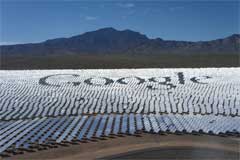No sooner it seems than we ran an article on the bright future of solar technology, given how prices for panels continue to fall while performance improves (See Solar Costs Increasingly Competitive, Soon to be More So), then we receive sort of contrary news on the effectiveness of a major and much touted solar power plant in California.
The Ivanpah Solar Electric Generating System covers some 5 square miles along the California-Nevada border, and is the largest solar power plant of its type in the world - once promoted as a potential inflection point in green energy production.
The plant generated about 250,00 MWh in its first eight months of operation (January through August, based on Energy Information Administration data), and thus was on course to fall well short of the annual 1,065,000 MWh anticipated for the plant.
Among the key factors: too many cloudy days.
"Factors such as clouds, jet contrails and weather have had a greater impact on the plant than the owners anticipated," the California Energy Commission, said in a statement.
The Ivanpah plant cost some $2.2 billion to build, and was backed by $1.6 billion in federal loan guarantees from the Dept. of Energy. The plant is operated by NRG Energy, which co-owns it with Google and BrightSource Energy.
"During startup we have experienced ... equipment challenges, typical with any new technology, combined with irregular weather patterns," NRG spokesman Jeff Holland said in a statement. "We are confident that Ivanpah's long-term generation projections will meet expectations."
BrightSource stated that the "annual expected generation noted by some in the media is for the mature year performance, which will occur at the 4-year mark of plant operations in 2018," saying some of the criticism from the early performance numbers was unfair. However, the web site BreakingEnergy says that BrightSource never mentioned a four-year timetable for the plant to get up to full speed as the story first broke, although the company did say that it "knew there might be some growing pains along the way."
The technology used at the facility is complicated. It is different than the familiar photovoltaic panels commonly used for rooftop solar installations. The plant's solar-thermal system - sometimes called concentrated-solar thermal - relies on nearly 350,000 computer-controlled mirrors at the site, each the size of a garage door.
The mirrors reflect sunlight to boilers atop 459-foot towers - each taller than the Statue of Liberty. The resulting steam drives turbines to create electricity.
Kaitlin Meese, an analyst at research firm Bentek Energy, told the Associated Press that the early production figures "do not paint a strong picture for solar-thermal technology development."
 The operation of plants using this type of solar technology is highly dependent on weather conditions, and of course predicting when and how strongly the sun will shine is far from a perfect science. The operation of plants using this type of solar technology is highly dependent on weather conditions, and of course predicting when and how strongly the sun will shine is far from a perfect science.
A little bit of inefficiency with mirrors can translate into a loss of power output ranging from small to significant, said Dr. Neil Fromer, executive director of the Resnick Sustainability Institute at the California Institute of Technology.
Problems could include getting the thousands of mirrors pointed in precisely the right direction, especially in the cool early morning, or keeping them clean in the dusty Mojave Desert.
Operators initially expected to need steam from natural gas-powered boilers for just one hour a day during startup. After operations began, they found they needed to keep boilers running more than four times longer - an average of 4.5 hours a day.
State energy regulators in August approved the plant's request to increase the natural gas it is allowed to burn by 60%.
Additional natural gas could also be needed to operate boilers when clouds thicken or to maintain output at the end of the day and extend the capability for power production, the company said.
"Because the plant requires sunlight to heat water and turn it to steam, anything that reduces the sunlight will affect steam conditions, which could damage equipment and potentially cause unsafe conditions," said the commission, which approved the request for increased gas use.
Fromer said it was surprising that so much additional gas is needed, adding that it "signals to me they have some very large problems that they are going to need to sort out."
So in the end, it seems this is perhaps largely a problem of a particular, relatively untested type of solar technology, rather than an indictment of solar in total, though we all would be well reminded that in the end, for solar to work, the sun needs to be shining.
However, BrightSource said that on an aggregate basis, for the month of September, it was a above the cumulative annual guaranteed level. Responding to questions about that statement, BrightSource explained in an email that September's performance had lifted Ivanpah's production rate and that the plant was now on course to meet its annual "performance obligation."
"We remain confident that over time the sun at Ivanpah will be more than sufficient for the plant to meet its expected performance targets," the statement said.
We will keep following this one.
What do you think of this Ivanpah solar plant? Problems with the core technology, or just start up pains? Let us know your thoughts at the Feedback button below.

TheGreenSupplyChain.com is now Twittering! Follow us at www.twitter.com/greenscm
|